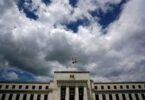F.P. Report
ISLAMABAD: The finance ministry in its debt policy statement FY2019-20 has conceded that Pakistan’s public debt and liabilities have increased by Rs11,610 billion or about 39 percent in 15 months.
In a report, the finance ministry noted that the total debt and liabilities that stood at Rs29,879 billion as of July 1, 2018, and crossed Rs41,489 billion by September 30, 2019.
It also observed that the total debt and liabilities increased by 86.3pc of GDP at the end of FY18 to 94.3pc of GDP at the end of September 2019. It said the government’s domestic debt increased by Rs6,234 billion or 38pc in the 15 months. It said the government domestic debt that stood at Rs16,416 billion at end-June 2018 increased to Rs20,730 billion by end-June 2019 and reached Rs22,650 billion at end-September 2019.
“The federal fiscal deficit (excluding grants) was recorded at Rs3,635 billion or 9.4pc of GDP during FY 2018-19, thus, remaining higher than the threshold of four percent,” said the debt policy statement.
For the same period, it further noted that the government domestic debt that stood at Rs16,416 billion at end-June 2018 increased to Rs20,730 billion by end-June 2019 and reached Rs22,650 billion at end-September 2019.
Government’s external debt during the 15-month period also increased by 36pc or Rs2,802 billion to Rs10,598 billion from Rs7,796 billion. External liabilities on the other hand increased by 160pc to Rs1,600 billion by September, 30, 2019 from Rs622 billion at June, 30, 2018.
“However, total public debt to GDP ratio reached 72.1pc while total debt of the government to GDP ratio was 66.5pc. Total public debt and total debt of the government as percentage of GDP stood at 84.8pc and 76.6pc, respectively at end June 2019, thus, increasing further during the FY 2018-19,” the finance ministry conceded.
“EDL was recorded at $106.3 billion by end June 2019, registering an increase of $11.1 billion compared to an increase of $11.8 billion recorded a year earlier. One half of the increase in EDL was due to rise in SBP liabilities in the form of deposits placed by bilateral partners (Saudi Arabia, the UAE, Qatar), and that these deposits only provide balance of payments support, add to foreign currency reserves and do not come as an extra resource in the budget”.
Pakistan’s External Debt and Liabilities (EDL) include all foreign currency debt contracted by the public and private sector, as well as foreign exchange liabilities of the State Bank of Pakistan. The EDL part that falls under government domain is the debt which is serviced out of consolidated fund and owed to International Monetary Fund (IMF) whereas remaining includes liabilities of central bank, debt of public sector entities, private sector and banks.
The pace of debt accumulation accelerated further in FY19 (Figure 5.1). In absolute terms, Pakistan’s total debt and liabilities (TDL) increased by Rs 10.3 trillion, which was more than twice the accumulation in FY18. Despite high deficit in FY19, its contribution to the overall debt accumulation was limited to only a third; the rest was attributed to: (i) an upward revaluation of existing stock of external debt following the depreciation of the Pak rupee; (ii) foreign exchange inflows from Saudi Arabia, UAE and Qatar, for balance of payments support; and (iii) government borrowing over and above the budgetary requirements that remained in the deposits with the banking system.
The largest contribution to the TDL came from the gross public debt. Distributed almost evenly across domestic and external sources (Figure 5.3), the increase in gross public debt during FY19 was unprecedented and, even after adjusting for the impact of exchange rate-led revaluation, highlights serious concerns on the fiscal front. For one, total debt of the government (gross public debt minus government deposits) reached 76.6 percent of GDP at end FY19 – an increase of 10 percentage points in a year – far above the level prescribed under the (Amended) Fiscal Responsibility and Debt Limitation Act (FRDLA), 2017. In addition to government debt, debt incurred by public sector enterprises (PSEs) continued to move along an upward trajectory, as a number of energy-related PSEs struggled to acquire a semblance of financial viability; PSE debt as percent of GDP increased by another 1.3 percentage points during FY19.
At its core, the deterioration in government debt indicators is primarily an outcome of incomplete structural reforms in fiscal and energy sectors and weak public financial management, which has widened the resource gap for the government. In particular, revenue deficit has steadily been increasing over the last 3 years, implying that the bulk of recent debt accumulation by the government was meant to finance its current expenditures, instead of adding to the repayment capacity of the economy. Similarly, the increase in primary deficit has also contributed, as the government is increasingly falling short of resources to service even the existing debt stock. In this context, an additional setback the government faced in FY19 was the steep rise in interest rates and depreciation of the Pak rupee, which escalated its debt-servicing burden; mark-up payments alone ate up 47 percent of the total tax revenues. With rising debt burden and its costly servicing, it has become challenging for the government to create space for spending on infrastructure, human capital development, and social protection, which are crucial for developing a competitive economy while achieving sustainable growth.
While addressing these challenges necessitates decisive fiscal reforms, especially on the revenue side, important developments took place in FY19 from debt management perspective. Most notable among these was the re-profiling of domestic debt towards the end of the year. Although the government relied heavily on direct short-term borrowing from the central bank through most of the year, which continued to shorten the average maturity of public debt, it replaced the stock of short-term MRTBs held by the SBP into long-term PIBs of various maturities. This re-profiling was put into effect in the month of June 2019, which took the share of long-term debt (permanent and unfunded) in total domestic debt from 45.8 percent at end FY18, to 73.4 percent at end FY19. While this structural shift would spread out maturity schedule of public debt and help alleviate the rollover risk for the government, debt servicing burden may become costlier to the tune of the spread between yields of 6-month MRTBs and PIBs.1 Moreover, with expectations of interest rate hikes gradually fading away, commercial banks are also getting more inclined towards locking their funds in long-term instruments. Their participation in PIB auctions improved towards the end of FY19 and their outstanding investment in these instruments, after falling steadily over the past couple of years, posted an increase of Rs 425 billion in H2-FY19.
As for the management of government external debt, multiple challenges continued to persist. First, the average cost of government external debt has increased with greater mobilization of commercial loans by the government over the past few years (Figure 5.4). In FY19 also, the share of commercial loans increased further to 12 percent of the government external debt by the end of the year (up from only 2.4 percent just three years ago).2 Moreover, with most of the fresh loans being contracted at floating interest rates, future debt servicing is getting more vulnerable to the trends in global interest rates. Second, from sustainability perspective, relevant indicators show a deterioration in both debt bearing capacity and servicing capacity of the country. In fact, servicing of external debt has become a key source of the country’s BoP needs down the road. Importantly, there is a need to shore up the level of country’s foreign exchange reserves and earnings (exports and remittances) to smoothly pay off debt obligations.
In this context, the 39-month extended fund facility agreement with the IMF will be helpful in plugging the financing gap. On the external front, narrowing of current account deficit during FY19 is quite encouraging, and with ongoing stabilization measures in place (including the flexible exchange rate regime), the BoP situation is expected to improve further.
Nonetheless, significant consolidation is needed on the fiscal front, as cuts in development expenditure alone would not be enough to control the size of primary deficit. Focus should be to increase revenues along with reduction in current expenditures to control the pace of the debt accumulation. Moreover, rationalization of energy sector policies and improving the governance of PSEs should also top the reform agenda of the government to cut down PSE debt.






